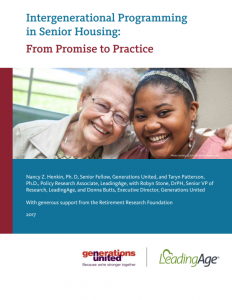 Download the Full Report
Download the Full Report
There is a growing interest among senior housing providers in intergenerational programming as a vehicle for connecting residents to the broader community, enhancing well-being for both youth and older adults, reducing ageism, and preparing an aging workforce. The report also highlights challenges and effective strategies for overcoming barriers, and identifies technical assistance needs. Finally, it includes four “Spotlights” that focus on different ways providers can integrate multigenerational activities into senior housing.
Key findings from the study include the following:
- Many housing providers have integrated a range of intergenerational activities into their overall programming and see positive benefits for residents and youth.
- Most housing sites, with some exceptions, focus on engaging residents in specific activities, rather than employing more general strategies to foster cross-age relationships.
- Most intergenerational efforts identified are short-term or one-time events and do not require a major commitment of time.
- Residents engage in both active and passive activities. Although residents in some properties are actively involved in planning and implementing intergenerational programs, most activities are planned by members of the housing team.
- Most providers have not identified clear outcomes for older adults or youth, nor have they conducted formal program evaluations.
- There is limited training of staff and volunteers.
Numerous provider-level challenges emerged and a variety of effective practices are outlined in each section of this report. Challenges include:
- Insufficient staffing dedicated to intergenerational programming;
- Difficulties with engaging older adults;
- Transportation for both youth and elders; and
- Lack of time to plan activities with partners due to other responsibilities.